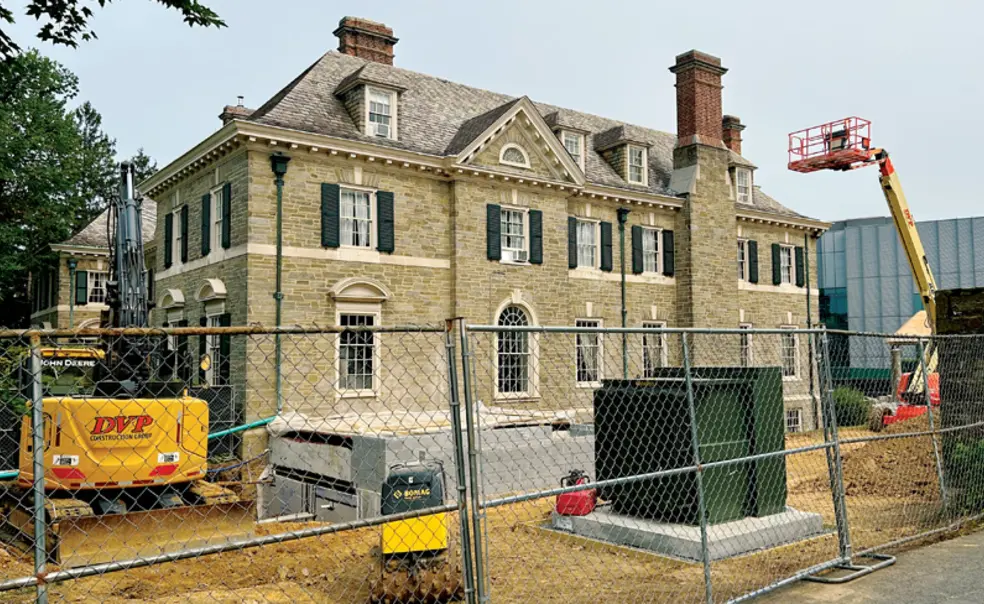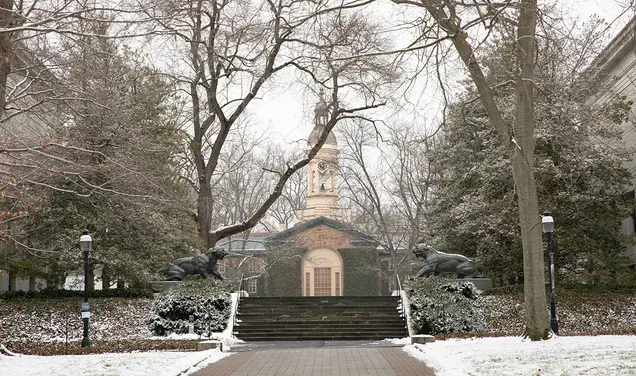Some Eating Clubs Expand to Meet Demand While Others Struggle
Interest is up in eating clubs, but it isn’t equal along Prospect Avenue
The Ivy Hall Eating Club began when 13 students rented the west room of a building on Mercer Street in fall of 1878. In 1879, when 11 new members joined those seniors to dine at Ivy, the club expanded — by renting the eastern room, across the hall.
Today, three of the 11 eating clubs — Charter, Cannon Dial Elm, and Tower — are expanding, and a fourth, Cloister Inn, has paused operations as it plans major renovations. Nowadays, the process involves more than setting another table.
Prospect Avenue hasn’t seen such construction since renovations at Ivy, Cap and Gown, and Tiger Inn in the early 2010s. These changes come near the end of a four-year expansion of the student body that began in 2022, and they coincide with rising levels of interest in the eating clubs. In February, the Interclub Council reported that 83% of the Class of 2027 had participated in Street Week, up from 80% the year before, and the 1,263 students offered spots in bicker and sign-in clubs was a new record.
This demand isn’t equal across the board — and as clubs compete for relevancy and student interest, they often take a long look at their clubhouses.
At Charter, alumni leaders are responding to demand: After years of stagnation, the club has taken in more than 100 students each year since 2020 through its selective sign-in process that tracks prospective members’ interest. Though Charter has a large clubhouse, its facilities have struggled to keep up.
“With 200 members, our dining room is not sufficient,” said Bob Klein ’78, a member of Charter’s board of governors. Members often eat in the club’s great room, and to maximize space, serve themselves at a buffet in the foyer.
Charter’s board began planning renovations to its 1913 clubhouse soon after the boom in membership. In 2022, it commissioned Ford 3 Architects — whose work includes renovations of historic buildings at Rutgers and Penn — to design an expansion. Fundraising began in October 2023. As of August, Charter had raised $5.95 million of its $6.35 million goal, Klein said.
With the campaign, dubbed “Project 79,” Charter will enclose its patio to create a second dining room. A back patio, second-floor roof deck, and outdoor pavilion will increase leisure space. Behind the scenes, the club will modernize its kitchen and offices and automate an aging hand-powered dumbwaiter.
James Beacham ’27, who joined Charter in the spring, told PAW he chose the club because he liked the house and appreciated that its selective sign-in process meant he could be sure he and his friends would eat together as juniors. Though he hasn’t felt crowding to be a major issue in his first semester as a member, he’s looking forward to having more space for dining and socializing. “Charter was already, like, a relatively big house,” he said. “But having Charter being one of the biggest houses on the Street will be pretty exciting.”
The project will also improve accessibility. Today, only Charter’s basement kitchen, office, and recreation spaces are wheelchair-accessible. Soon, pathways will lead to an accessible side entrance with an elevator connecting the basement to the first and second floors. The club also added an accessible restroom on the first floor and will renovate a basement bedroom that will have ADA-compliant access to all floors via the elevator.
Construction began after Reunions this past May. Klein said builders finished the new restroom in July, while the rest of the expansion should be completed by Reunions next year. As the bulk of the expansion is at the house’s rear, impacts to club life this year should be minor.
Down the Street, Cannon Dial Elm will also expand its footprint. The “Thrive in ’25” plan aims to improve quality of life in the crowded house.
The club reopened in the renovated Cannon clubhouse in 2011 after a previous incarnation closed in 1998. Despite recent updates, Cannon faces strains when hosting large events like formals or parents’ weekend, according to board of governors chairman Charles Freyer ’69.
“Our facilities accommodate our current members well but are taxed when a large number of guests are present,” Freyer wrote in an email to PAW. The club’s plans include an addition to dining space alongside renovations to kitchen and servery equipment.
Freyer told PAW that a priority of the expansion project is increasing Cannon’s appeal for studying and socializing beyond mealtimes. As Briger Hall and the new engineering buildings on Ivy Lane bring academics closer to the Street, Freyer said Cannon’s leaders want the clubhouse to sit at the center of students’ life at Princeton and compete with other clubs.
A $1.5 million campaign began in November to fund the expansions. Freyer said construction will begin in late spring 2026, with completion intended by August 2026.
Next door, Tower Club is beginning its own small yet long-awaited addition: an elevator.
While the club’s first floor is wheelchair-accessible, Tower’s dining room is on its lower level. For Naomi Hess ’22, this made club life a challenge. While she could enter Tower’s front door in her wheelchair, Hess had to exit the club and re-enter through the kitchen on the lower level to eat meals.
“The door was not always open,” Hess said. “The path was very cramped … but I dealt with it to be part of the club.” As a student and alumna, Hess worked with Tower’s board of governors to develop plans for an accessibility overhaul.
The COVID pandemic and designation of most of Prospect Avenue as a historic district in 2021 delayed the project, requiring Tower’s graduate board to develop plans that met historic preservation requirements.
“It’s been a long process,” Tower board member Patrick Yun ’92 wrote in an email to PAW.
Princeton’s municipal planning board approved plans this past March, alongside improvements to the club’s driveway. Construction should begin next June.
Hess is happy that Prospect clubs are improving accessibility but stressed they will need to educate members and staff on the needs of members with mobility challenges.
“These structural improvements like elevators will certainly go a long way,” Hess said. “But there’s also just cultural issues to work on as well.”
Even with growing interest in the eating clubs, demand is not even. Among sign-in clubs, Quadrangle, Colonial, and Cloister Inn remain under capacity, while Terrace and Charter have long wait-lists for membership. In January’s most recent round of bicker, Tiger Inn and Cap and Gown each turned away three-quarters of interested students, while Cannon Dial Elm admitted 60% of bickerees.
At Cloister Inn, concerns over recruitment go hand in hand with renovations. The club’s board of governors announced in June that Cloister would shut for the next two to three years pending a reimagining of the club’s identity and spaces.
Mike Jackman ’92, chairman of Cloister’s board of governors, told PAW in June that the club’s struggles to recruit members despite record interest in the Street necessitated serious action. Jackman aims to produce a plan for Cloister’s reimagining by the end of 2025.
Amid the boom in club interest and undergraduate class size, even clubs without current expansion plans acknowledge the need to consider potential action.
Terrace Club has decided against expansion twice in the past 15 years, even as membership has grown. In 2013, tentative plans were mothballed due to fiscal uncertainty. In 2018, the club released architectural renderings of an expansion and announced a $3.5 million campaign, with plans to kick off fundraising at Reunions 2020. But the pandemic and its complications froze the “Terrace Future Campaign” indefinitely.
Since then, the club has completed smaller renovations — an expanded dining patio and renovated gender-neutral bathrooms — and focused on maintenance.
“Our club probably has a higher rate of entropy, I think, than some others,” said Andrew Kinaci ’10, chairman of Terrace’s board of governors. “It undergoes some pretty heavy usage.”
That doesn’t mean the club is ignoring changes on campus: As interest has grown, Terrace is considering new ways to engage students or envision future physical renovations.
These decisions aren’t made in a vacuum but rather coincide with other goings-on on the Street: Leaders at Terrace, Charter, Cannon, and Cloister all spoke to the importance of knowledge-sharing among the clubs through the Graduate Inter-Club Council.
“The GICC creates space for board leadership, undergraduate officers, and club managers and staff to learn about best practices,” the organization wrote in a statement to PAW. “The GICC doesn’t coordinate these projects, but rather brings together leaders from across the club community to share knowledge, experience, and expertise.”
“Each club does things a little bit differently,” Kinaci said. “But I think there’s a lot of … opportunity for us to learn more from one another.”












2 Responses
Laurence C. Day ’55
1 Month AgoAll Clubs Should Be Sign-in
I was a member of Colonial Club in the 1950s. Today it is a sign-in club, no longer selective, and has a membership that includes many Asian and Asian American students. All clubs should be sign-in. Ivy, Cottage, Tiger Inn, and Cap and Gown are out of step reflecting the Princeton of decades ago. Neither club should think of themselves as special in the club lineup. In my day Ivy was thought of as a boring self-satisfied inward group with Cottage trailing close behind. And both had no house party bands worth a plug nickel. Colonial was front and center with the best Eastern bands, hands down, over party weekends.
Paul Arnold
1 Month AgoThe Growing Campus
Thank you for the campus updates! Will visit in spring 2026 with Gavin Hurst, grandson and prospective applicant for fall 2027. The campus tour calls for hard hats!